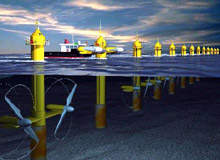
When it comes to exploiting wave and tidal power, the UK’s coastlines – notorious for being eroded by the harsh and ferocious breaking surf – seem a good fit.
The principal of harnessing tidal energy dates back to England’s Middle Ages when the concept was used to power the mechanisms in mills. Today, however, it is the relentless push and pull of the sea that could prove to be an efficient and important renewable source for generating the country’s electricity.

Discover B2B Marketing That Performs
Combine business intelligence and editorial excellence to reach engaged professionals across 36 leading media platforms.
Exploiting the potential of its island status, a number of UK companies are exploring innovative new ways of harnessing the power of the ocean. In particular, Scotland has emerged as a leading centre for research and development in the field of tidal energy.
New technology is playing an essential role in these developments as the relative infancy of using tidal energy means the concept is yet to be widely implemented anywhere in the world. An example of this can be found in Scotland, where the Aberdeen-based renewable energy company Green Ocean Energy (GOE) has been busy researching a new floating offshore device to convert the ocean’s energy into electricity, called Ocean Treader.
Treading carefully
Moored within a few miles of the coastline, Ocean Treader is designed to harness the different responses of horizontal and vertical floating bodies to passing waves. According to GOE, the device has been proven in tank testing and the company is now raising funds to build a full-size prototype that it plans to trial offshore before 2010.

US Tariffs are shifting - will you react or anticipate?
Don’t let policy changes catch you off guard. Stay proactive with real-time data and expert analysis.
By GlobalDataRather uniquely, the company used working digital prototypes rather than physical versions during the testing process. With testing done on screen and any potential problems fixed before a physical construction was created, GOE saved time and cost during the tentative early stages of the project.
The Ocean Treader is now going through the model iterations stage, where 3D imaging has allowed GOE to examine the design of the device. This has proved vital to the company as the need to guarantee the product to be reliable in tenuous conditions is paramount. Analysing the system’s strengths and weaknesses has helped ensure the Ocean Treader has few single points of failure – a fact GEO hopes will secure the concept the necessary financing.
Moving upstream
A tidal energy system much further down the development line is SeaGen, a unique underwater industrial-sized turbine that has been breaking records since its trial implementation at Stangford Lough, Northern Ireland. It has been developed by the Bristol-based firm Marine Current Turbines (MCT) and the $20m commercial scale project became the first tidal turbine to ever hit a capacity of 1.2MW in December 2008.
The success of the project highlights the now-very real potential of tidal energy and in particular the value of tidal stream locations. Tidal streams, such as Strangford Lough, are big masses of water moving on the Earth’s surface as a result of the gravitational attraction of the moon. Such streams have accelerated flow which can be harvested by tidal generators that in the instance of SeaGen, takes the form of giant underground propellers.
The growing confidence in such technology has led MCT’s next project to be an astounding 10.5MW tidal energy farm off the coast of the Welsh island of Anglesey. Located in a fast flowing patch of 25-metre-deep open sea known as The Skerries, the project will be a joint venture with UK energy supplier npower and, subject to successful planning consent and financing, could be commissioned as early as 2011.
The dawn of a new tide
With experts highlighting tidal power as a far more predictable source of renewable energy then the sun or wind, the potential of tidal energy speaks for itself. As the technology matures through successful projects such as the ones mentioned above, widespread adoption of tidal power in the UK could become a prominent part of the country’s future river and seascape.
Sources for this article first appeared in our sister publication: Computer Business Review (www.cbronline.com)





